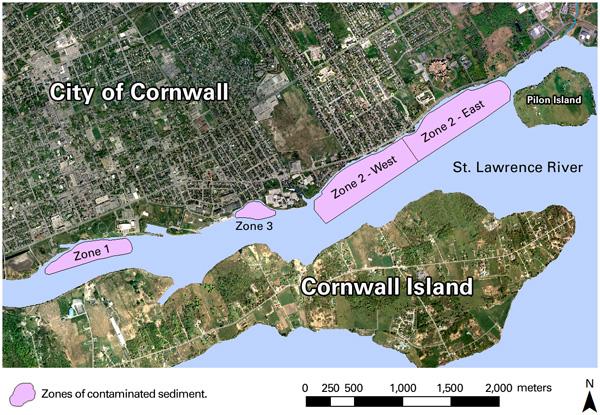May 20, 2015
It is hard to believe now but a few short decades ago, industrial waste and other pollutants were often discharged directly into the St. Lawrence River. Contrary to popular belief, some of these contaminants did not flow away, they settled and built up in high concentrations in the sediment in the River bottom along Cornwall’s waterfront. On Wednesday, May 27th, Raisin Region Conservation Authority (RRCA) will lead a workshop focussing on the Cornwall shoreline that is geared towards homeowners, marine contractors, and builders to provide information on the Cornwall Sediment Strategy. This interactive information session will provide details and options surrounding waterfront development in areas deemed vulnerable to stirring up old sources of this pollution. The workshop is free of charge and will take place at OPG St. Lawrence River Power Development Centre (2500b Second St. West) at 6:30 pm.
Sediment contamination is one of the main reasons that the upper St. Lawrence River at Cornwall was designated as a Great Lakes hotspot, or Area of Concern three decades ago. The chief contaminant in this sediment is mercury, a toxic substance that stays in the environment for years. With stricter environmental regulations and the closure of several industries, cleaner sediment has begun to settle over three key areas of sediment contamination along the Cornwall waterfront. A natural barrier cap has been created as a result of the implementation of a set of controls called the Cornwall Sediment Strategy. These regulations were developed and are currently administered by a team of environmental partners who have been working together for over a decade to ensure that contaminated sediment in these sensitive zones are not being disturbed. Partners include the City of Cornwall, Mohawk Council of Akwesasne, Raisin Region Conservation Authority, Ontario Ministries of the Environment and Climate Change and Natural Resources and Forestry, Environment Canada and the federal Dept. of Fisheries and Oceans.
Developed in 2005, the Cornwall Sediment Strategy calls for special care to be taken in 3 designated zones where contaminated sediment is known to exist. To ensure that sediments are not disturbed in areas that are zoned as contaminated, there are specific rules surrounding waterfront projects such as building a dock or restoring a shoreline. Plans must first be reviewed with the Raisin Region Conservation Authority (RRCA) as well as by the other agencies that belong to the Cornwall Sediment Strategy Accord which coordinates the approval process. It seems that the strategy is working. Long-term environmental monitoring is showing that while levels of mercury are still elevated, levels in surface sediment have decreased over the last few years and deeper, more contaminated sediment is slowly being covered over naturally with cleaner deposits.
Since being declared a hotspot in the Great Lakes area thirty years ago, the upper St. Lawrence River has been in recovery mode and monitoring the progress is still an important part of the process. Subsequently, last summer, scientists working with the River Institute, Dr. Roxanne Razavi, Matt Windle, and Dr. Jeff Ridal consolidated their expertise by embarking on a research project to gather core samples of sediment from the St. Lawrence River bottom along Cornwall’s waterfront. The detection of certain types of mercury in sediment and where it is found can provide important data to researchers seeking to determine how the St. Lawrence River is faring with respect to recovery from its polluted industrial past. The information gathered also provides beneficial information that will help to pilot the Cornwall Sediment Strategy Program in the years ahead.
- 30 -
Lissa Deslandes
Regulations Officer & Communications Coordinator
Raisin Region Conservation Authority
18045 County Rd. 2,
P.O. Box 429 Cornwall, ON K6H 5T2
lissa.deslandes@rrca.on.ca
www.rrca.on.ca
(613) 938-3611 (ext.237)
Karen Douglass Cooper
Remedial Action Plan Coordinator, St. Lawrence River (Cornwall)
St. Lawrence River Institute of Environmental Sciences
2 St. Lawrence Dr.
Cornwall, ON K6H 4Z1
kcooper@riverinstitute.ca
www.riverinstitute.ca
(613) 936-6620 (ext.229)

